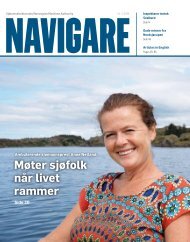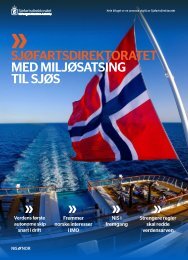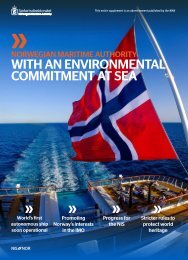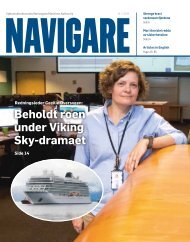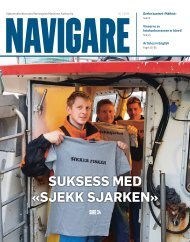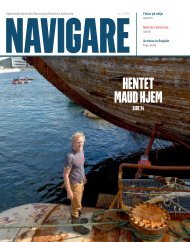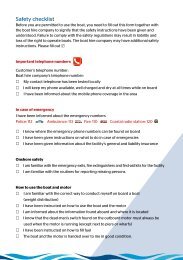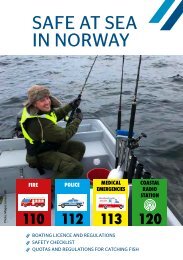Navigare 2- 2017
Create successful ePaper yourself
Turn your PDF publications into a flip-book with our unique Google optimized e-Paper software.
EDITORIAL<br />
ENGLISH TRANSLATION FROM PAGE 4<br />
SAFER TO WORK AT SEA<br />
The number of accidents in the shipping<br />
industry is decreasing. The accident statistics<br />
for 2016 show a decrease in the number of<br />
shipping accidents and in the number of<br />
personal accidents on board Norwegian<br />
ships. In fact, we have to go back to 2009<br />
before we find a year with fewer shipping<br />
accidents than in 2016. The number of<br />
personal accidents has not been lower since<br />
1988/1989, and this is very good news. The<br />
long-term trend is also positive. In a perspective<br />
of thirty years, the number of deaths<br />
in Norwegian shipping has decreased by<br />
close to 90%. Despite this positive development,<br />
it is still more dangerous to work at sea<br />
than it is to work on shore. In 2016, seven<br />
people lost their lives in connection with<br />
work on Norwegian vessels. Six of these lives<br />
were lost on fishing vessels.<br />
Both the industry and the Norwegian<br />
Maritime Authority are working hard to<br />
reduce the number of accidents. Accidents<br />
can be prevented. Good routines for safe<br />
operation will reduce the risk of accidents.<br />
Even though things are going in the right<br />
direction, I still think that more can be done<br />
to decrease the number of accidents even<br />
further. The objective must at least be that it<br />
is equally safe to work at sea as it is to work<br />
on shore.<br />
Even though the Ship Safety Act<br />
maintains that it is the responsibility of the<br />
shipowner to ensure safe operation of the<br />
vessel and compliance with laws and<br />
regu lations, the Norwegian Maritime Authority<br />
also has responsibilities - to develop rules<br />
and regulations, methods and inspections, so<br />
that we have as few accidents as possible.<br />
Over a number of years, the Authority has<br />
worked towards becoming more risk based in<br />
its work methods. In other words, finding a<br />
system through which our efforts are put into<br />
that which will give the greatest effect on the<br />
reduction of accidents. We have carried out<br />
Olav Akselsen<br />
Director General of Shipping and<br />
Navigation<br />
annual risk assessments, published an annual<br />
Risk Assessment Report and decided on<br />
annual focus areas. We believe that this has<br />
had a positive effect and the Authority has<br />
become more goal-oriented in its work to<br />
prevent accidents. We now take yet another<br />
step on our way to become risk based in our<br />
supervisory work.<br />
From 1 June <strong>2017</strong>, a new system for<br />
inspections will be introduced. The objective<br />
is that our inspectors shall focus more on and<br />
spend more time on the vessels and the<br />
shipowners that pose a greater risk, and<br />
spend less time on the low risk vessels.<br />
Shipowners that have demonstrated good<br />
and safe operation over a period of time will<br />
experience that the Authority uses less time<br />
on their vessels, whereas high risk vessels will<br />
be subject to a more detailed and thorough<br />
inspection.<br />
A new model will help determine whether<br />
the vessel is a high, medium of low risk<br />
vessel. Former deficiencies, detentions, age<br />
and accidents will help determine the risk<br />
associated with the ship.<br />
The Norwegian Maritime Authority has<br />
over a long period of time, worked to adapt<br />
procedures and checklists to suit a more risk<br />
based way of working. In addition, our<br />
inspectors have received thorough training in<br />
the new inspection method. The new method<br />
for risk based inspections will be used for<br />
inspection of certificates, ISM audits and<br />
unannounced inspections on Norwegian<br />
vessels.<br />
I hope and believe that this new and more<br />
targeted way of carrying out inspections will<br />
lead to more findings, and that ships of the<br />
poorest quality either are upgraded or phased<br />
out. This may contribute to an increase in the<br />
quality of Norwegian vessels. I also hope and<br />
believe that the new inspection method will<br />
increase safety and furthermore contribute to<br />
a decrease in the number of accidents, so that<br />
it will be even more safe to work on board<br />
Norwegian vessels.<br />
<strong>Navigare</strong> 2 - <strong>2017</strong> | 59










